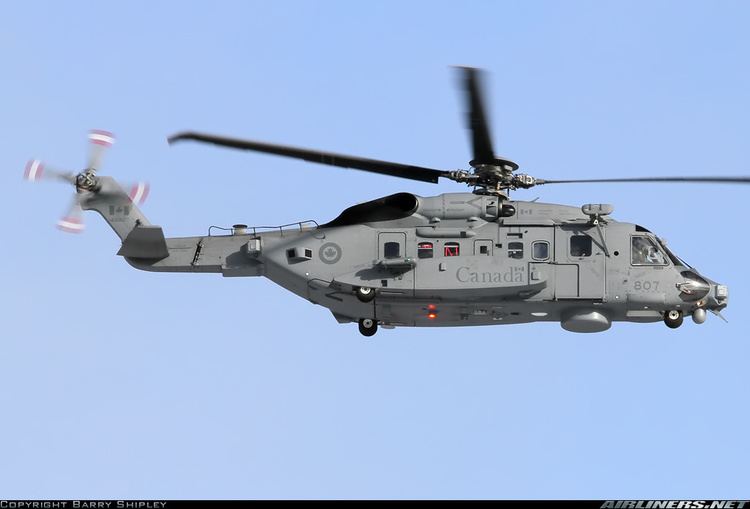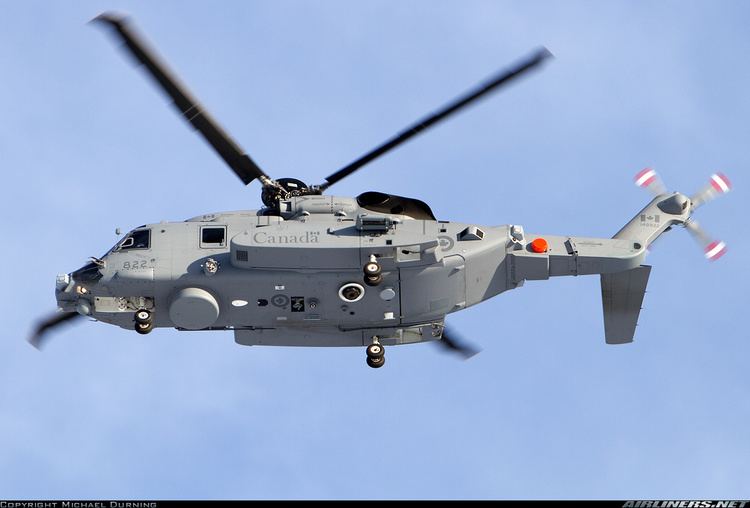Top speed 306 km/h Wingspan 18 m Engine type General Electric T700 | Length 21 m Cruise speed 254 km/h Manufacturer Sikorsky Aircraft | |
 | ||
Unit cost 64,000,000–64,000,000 CAD (2004) | ||
Sikorsky ch 148 cyclone top 5 facts
The Sikorsky CH-148 Cyclone is a twin-engine, multi-role shipboard helicopter being developed by the Sikorsky Aircraft Corporation for the Canadian Forces. A military variant of the Sikorsky S-92, the CH-148 is designed for shipboard operations and is intended to replace the venerable CH-124 Sea King, which has been in operation since 1963. The search for a Sea King replacement originally began in the 1980s.
Contents
- Sikorsky ch 148 cyclone top 5 facts
- Origins
- Delays and upgrades
- Design
- Operational history
- Variants
- Operators
- Specifications
- References

The Cyclone is to be operated by the Royal Canadian Air Force (RCAF) and will conduct anti-submarine warfare (ASW), surveillance, and search and rescue missions from Royal Canadian Navy warships. The helicopter is also to provide tactical transport for operations supporting national and international security efforts. In 2004, Canada awarded Sikorsky Aircraft a contract for 28 CH-148s with deliveries planned to start in 2009. Deliveries were repeatedly delayed due to development problems until the delivery of six initial helicopters in June 2015.

Origins
Canada began to seek a replacement for the Sea King maritime helicopter in 1986 when it issued a solicitation for the New Shipborne Aircraft (NSA) Project. A variant of the AgustaWestland EH-101 was selected and a contract was signed by the nation's governing party at the time, the Progressive Conservatives. After a change of government to the Liberal party, the EH-101 contract was cancelled. The cancellation resulted in a lengthy delay to procure a replacement aircraft. The project took on increased importance in the early 2000s and another procurement competition was initiated.

On 23 November 2004, Canada's Department of National Defence announced the award of a C$1.8 billion contract to Sikorsky to produce 28 helicopters, with deliveries scheduled to start in January 2009. In addition to Sikorsky, General Dynamics Canada and L-3 MAS, Sikorsky's subcontractors, are responsible for in-service maintenance and the Maritime Helicopter Training Centre, which includes two Operational Mission Simulators. Other elements of in-service support include the Integrated Vehicle Health Monitoring System, spares and software support.

The first flight of the first production CH-148, serial number 801 (FAA registration N4901C), took place in Florida on 15 November 2008.
Delays and upgrades

In May 2010, Sikorsky announced an engine upgrade for the CH-148 Cyclone by the end of 2012. General Electric is developing a new engine version based on the CT7-8A1. The CT7-8A1 makes the CH-148 Cyclone heavier and less efficient than expected. General Electric is currently developing the CT7-8A7 to be certified by June 2012 and eventually integrated into the Cyclone as soon as possible. General Electric will develop the upgraded engine at its own expense. The new CT7-8A7 engine version will produce 10% additional horsepower. The CT7-8A7 will include modifications to the fuel manifold and nozzles. The interim CH-148s will be provided with CT7-8A1 engines.
Additional complications in the program, and restrictions from US government International Traffic in Arms Regulations have delayed initial aircraft deliveries until 2010. Further delays resulted in expected delivery pushed to 2015. In 2013 Canada rejected the delivery of "interim" helicopters offered by Sikorsky that lacked critical mission systems. In September 2013, the Canadian government announced that they were reevaluating the CH-148 purchase, and would examine cancelling the contract and ordering different helicopters if that were the better option; by this point, Sikorsky had accrued over $88 million in late damages since 2008.
In June 2014, it was announced that the Canadian government had removed the mandatory requirement from Sikorsky to supply the CH-148 with a 30-minute run-dry main gearbox. This was a key safety feature defined as mandatory in the original RFQ and one of 7 concessions made to Sikorsky. The Canadian government states these concessions will not affect the safety of Armed Forces personnel. However, oil loss in the main gearbox followed by several other factors caused the 2009 crash of a S-92, a civil version of the helicopter, off the coast of Newfoundland. Sikorsky has added an oil cooler bypass switch and states a similar accident is extremely unlikely. The effectiveness of the bypass switch has been questioned as it assumes that the leak will happen within the oil cooler assembly, and that the bypass can be activated in time to maintain enough oil. In the case of the S-92 crash, a titanium stud sheared causing catastrophic oil loss through the oil filter assembly.
Design
The CH-148 has a metal and composite airframe. The four-bladed articulated composite main rotor blade is wider and has a longer radius than the S-70 Blackhawk. The tapered blade tip sweeps back and angles downward to reduce noise and increase lift. Tethered hover flight has recorded 138 kN (31,000 lbf) of lift generated, both in and out of ground effect. Unlike the Sea King, but in common with almost all current production naval helicopters, the Cyclone is not amphibious and cannot float on water.
A number of safety features such as flaw tolerance, bird strike capability and engine burst containment have been incorporated into the design. An active vibration system ensures comfortable flight and acoustic levels are well below certification requirements. The Cyclone will feature a modified main gearbox, which has been redesigned since a March 2009 accident.
The CH-148 is equipped with devices to search and locate submarines during ASW, and is equipped with countermeasures to protect itself against missile strikes. The Integrated Mission System is being developed by General Dynamics Canada, as is the Sonobuoy Acoustic Processing System. The radar is a Telephonics APS-143B, the EO System a Flir Systems SAFIRE III, the sonar an L-3 HELRAS, and the ESM a Lockheed Martin AN/ALQ-210. CMC Electronics provides the flight management system, named CMA-2082MH Aircraft Management System.
Operational history
The Canadian Forces were to take delivery of CH-148s beginning in November 2008. In April 2009 the Government of Canada waived late fees and allowed Sikorsky two additional years to deliver compliant Cyclones. In February 2010, the first CH-148 arrived at CFB Halifax. Shearwater Heliport is the headquarters of 12 Wing, which currently operate the CH-124 Sea King and are to operate the CH-148. Due to delays and export restrictions, the first 19 of the 28 CH-148 Cyclones were to be delivered in an interim standard which does not meet the original contract requirements. This allows operational testing and training to begin before the end of the year.
In March 2010, the first CH-148 was being installed on board HMCS Montréal for an intensive open seas trials including landing and takeoff. In June 2010, Sikorsky announced the Canadian Forces would receive six interim CH-148 Cyclones in November 2010. In July 2010, Sikorsky reached an agreement on delay payments and deliveries; deliveries of the remaining CH-148s with full capabilities were to begin in June 2012. All interim-standard helicopters were to be retrofitted by December 2013.
On 22 February 2011, the Office of the Prime Minister of Canada announced the proposed arrival of 9 Cyclones on Canada's west coast in the spring of 2014. By March 2011 the six interim CH-148s had not been delivered. On 3 March 2011, the federal government announced that it would impose a fine of up to C$8 million on Sikorsky for failure to meet contractual obligations. In January 2012 it was reported Sikorsky would deliver five training CH-148s in 2012, including one "fully mission capable" CH-148 by June 2012, or face a further possible $80 million in contract penalties. On 10 July 2012 in reference to Sikorsky missing another delivery deadline, Defence Minister Peter MacKay called the Cyclone purchase "the worst procurement in the history of Canada".
In December 2012, Louis Chenevert, chairman of Sikorsky's parent corporation United Technologies Corporation, stated that the 5 CH-148s scheduled for delivery in 2012 would instead be delivered in 2013, along with 3 additional helicopters. The remaining deliveries are to follow. In October 2013, the project appeared to be on the verge of cancellation with the Canadian government ordering a possible change to the maritime helicopter requirements.
In June 2015, it was reported that Sikorsky was ready to begin deliveries of the first interim Cyclones to the Royal Canadian Air Force. Six helicopters were delivered on 19 June 2015, and two "Block 1.1" Cyclones were delivered in November–December 2015. These eight helicopters will allow for RCAF training on the Cyclone until the fully operational Block 2 Cyclones start to arrive in 2018. A ninth CH-148 was delivered in August 2016.
Variants
Operators
Specifications
Data from Canadian Forces MHP page
General characteristics
Performance
Armament
